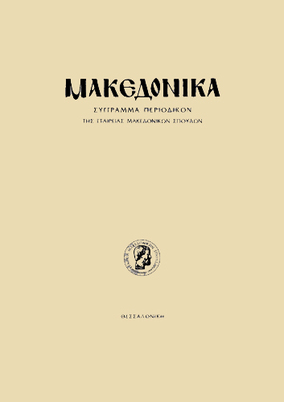Ο Kanurmâme και οι χριστιανοί κάτοικοι της Θεσσαλονίκης γύρω στα 1525
Part of : Μακεδονικά ; Vol.19, 1979, pages 328-395
Issue:
Pages:
328-395
Parallel Title:
The «Kanunnâme» and the Christian Inhabitants of Thessaloniki circa 1525
Section Title:
Articles
Abstract:
A «defter-i mufassal» with the names of the inhabitants of Thessaloniki circa 1525, preserved at the National Library of Bulgaria, was edited by the Bulgarian Academy of Letters in 1972. The same «defter» also contains part of a «kanunnâme», which indicates the taxes and dues paid in Thessaloniki at that time. The value of that document for the history of Thessaloniki is evident, as we possess only scarce material from that period.At first the author gives a new translation of the «kanunnâme» and analyzes the information given on the various dues mentioned in it. We can observe that almost a century after the last occupation of Thessaloniki by the Turks in 1430, there were still several Byzantine, mainly fiscal terms in use. One of them was «mayiriye», the Greek word μαγειρεία, indicating a small tax imposed upon the fish caught in the gulf of Thessaloniki. Another one was «monopolye», from the Greek μονοπώλιον, a tax levied on the products of the vineyards. Also, the harbour-master of Thessaloniki was named «kapudan», a term of By zantine origin, while in later times the same dignitary was called «reis».The Byzantine character of Thessaloniki, still preserved well into the 16th century, is more evident through the names of her Christian inhabitants as well as in the names of her districts («mahale»). Because these names have been mis read to a large extent by the Bulgarian scholar N. Popov in the Bulgarian edition of the «defter», a new reading is given here. These misreadings are due partly to the peculiarities of the «siyakat» script, in which the «defter» is writ ten, but mainly to a lack of good knowledge of the Greek language and Byzan tine nomenclature. Because this may lead scholars to false conclusions, examples of these mistakes are given in this article.The names of the Christian inhabitants are mainly of Greek origin with a large number of Byzantine family names of noble origin among them. There are also names of Serbian, Bulgarian, Albanian and Wallachian origin in small numbers. The professions of many inhabitants are also indicated. One notes al so a large percentage of widows among them. There were a few individuals or groups exempted from taxation. The first ones were Yannis Argyropoulos and Nikolas Paleologos, both of well known Byzantine noble families. Exempted also were four Christians who had the duty to keep in good order buildings for general use, like caravanserais, baths etc, and shops belonging to the sultan and other Ottoman dignitaries. This is an in dication of the importance of Byzantine influence upon the development of Ottoman architecture during its first centuries. A considerable number of Christians were also exempted from taxation because they worked at the armoury of the town, which existed since Byzantine times and continued functioning as a gunpowder factory until the last years of the Ottoman era.The «defter» becomes thus one more proof of the continuous presence of the same people from Byzantine times to the present day in Thessaloniki.
Subject (LC):
Notes:
856:https://ejournals.epublishing.ekt.gr/index.php/makedonika/article/view/6034, DOI: https://doi.org/10.12681/makedonika.473
Electronic Resources:




